Introduction
In the realm of child development, Pediatric Occupational Therapy (OT) stands out as a vital discipline aimed at fostering essential skills for daily activities and academic success. This specialized approach addresses a wide array of developmental needs, from fine motor skills to sensory processing and cognitive growth.
With a focus on individualized care, occupational therapists conduct comprehensive assessments to tailor interventions that resonate with each child's unique context. Recent advancements in the field underscore the importance of evidence-based practices, highlighting the significant role caregivers play in understanding and supporting their child's developmental journey.
As pediatric OT continues to evolve, it becomes increasingly clear that effective interventions not only enhance children's abilities but also empower families to engage actively in the therapeutic process, ensuring that every child can thrive.
1. Fundamentals of Pediatric Occupational Therapy
Pediatric Occupational Therapy (OT), also known as occupational pediatric therapy, is a specialized field focused on assisting young individuals in the development of essential skills for daily activities and academic success. This therapeutic approach encompasses a broad range of growth aspects, including:
- Fine motor skills
- Sensory processing
- Cognitive development
Occupational therapists perform comprehensive evaluations to recognize each individual's distinct requirements, subsequently creating customized strategies that improve their ability to participate in age-suitable activities.
Recent advancements in occupational pediatric therapy highlight a growing emphasis on personalized care, ensuring that strategies not only address specific growth challenges but also align with the individual’s unique context. According to Healthy People 2030 initiatives, the definition of a high-quality pediatric primary care team is being redefined to ensure accessible and equitable health services, which is crucial for effective OT practices. Furthermore, a recent review identified 40 measures that received a ‘strong’ recommendation for use, indicating a high-quality evidence base with more benefits than harms.
Caregivers who recognize the importance of OT can gain deeper insights into how these strategies assist in achieving milestones in growth. Additionally, a survey conducted at the Minnesota State Fair revealed caregivers' preferences for educational resources and communication methods with providers, highlighting the need for practitioners to tailor their approaches to meet unique family and child-caregiver communication needs. As supported by recent research, effective pediatric occupational therapy practices have been shown to yield significant improvements in youngsters' skill sets, reinforcing the critical role that occupational support plays in fostering holistic development.
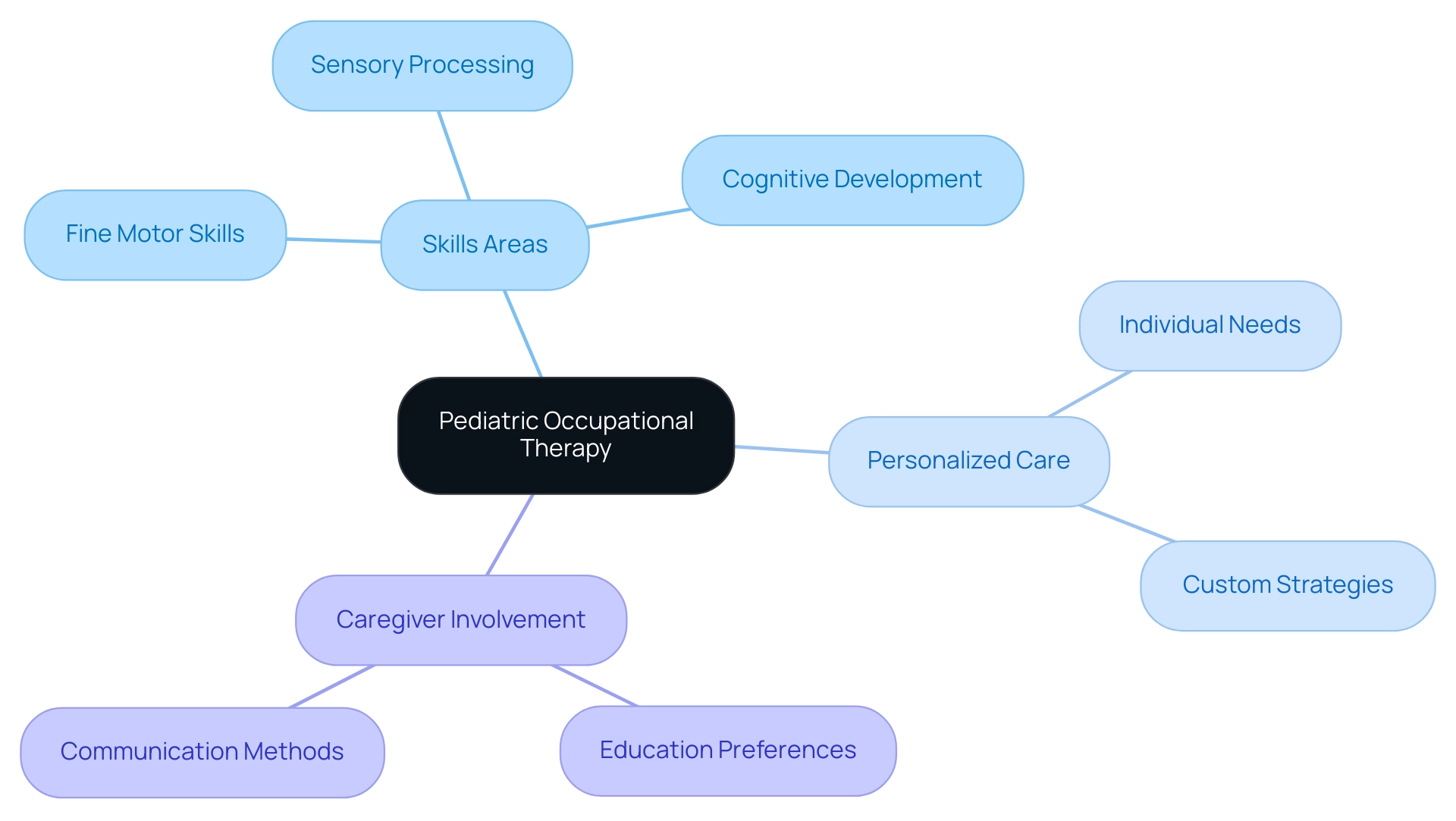
2. Benefits and Outcomes of Pediatric Occupational Therapy
Occupational pediatric therapy (OT) plays a crucial role in enhancing various growth outcomes for youngsters, particularly in improving fine motor skills essential for executing everyday tasks such as writing and self-care. Based on the 2018–2019 National Survey of Children’s Health (NSCH), roughly 1 in 6 youths aged 3 to 17 years have a developmental disability, highlighting the necessity for effective measures. Recent findings indicate that these interventions can lead to significant advancements in critical skills.
For instance, a study by Madlinger-Lewis et al. (2014) demonstrated the positive effects of alternative positioning on preterm infants in neonatal intensive care units (NICU), highlighting how targeted OT practices can foster development even in vulnerable populations.
Beyond fine motor proficiency, occupational pediatric therapy enhances sensory processing abilities, enabling youngsters to engage more effectively with their surroundings. This improvement is essential for navigating complex environments and can result in a more confident approach to learning and play. Furthermore, occupational pediatric therapy supports social-emotional development by assisting individuals in establishing meaningful relationships and enhancing their communication skills.
According to the American Occupational Therapy Association (AOTA), "occupational therapists use interventions to promote social-emotional learning, regulate overactive or underactive sensory systems, collaborate with families and medical or educational personnel, and more." This collaboration is vital in creating a supportive network for every individual.
These multifaceted benefits culminate in greater independence and self-assurance in young individuals, significantly contributing to their overall well-being and quality of life. As we approach 2024, the continued incorporation of occupational pediatric therapy practitioners into pediatric primary care models highlights the necessity for culturally responsive growth monitoring, addressing disparities in health care access. The case study titled 'Opportunities for Pediatric Primary Care Innovations' highlights the importance of coordinated interprofessional health care services to reduce health disparities and promote family health.
By fostering these services driven by community needs, occupational pediatric therapy aims to mitigate the impact of social determinants of health, ensuring that every young individual can thrive.
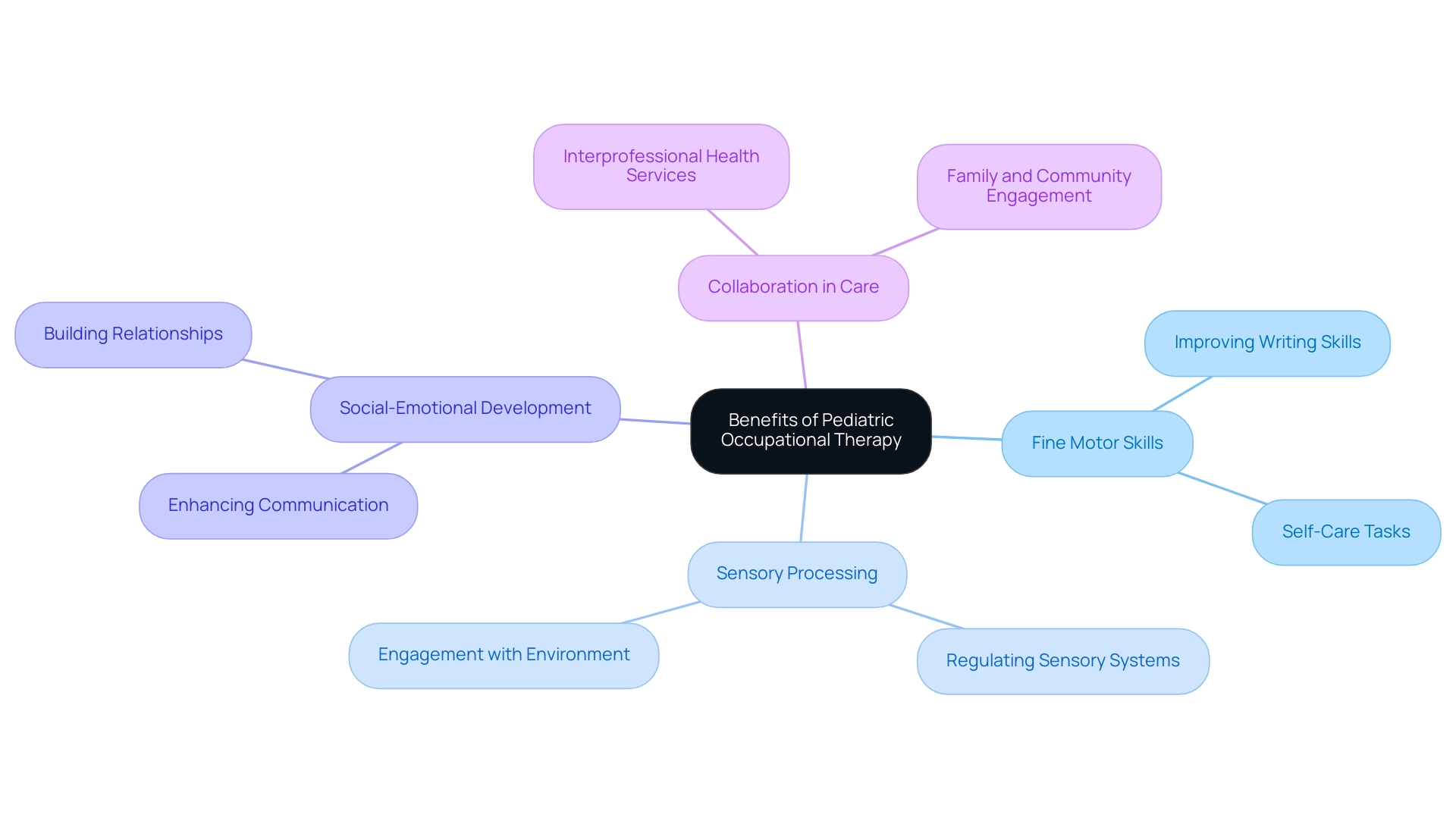
3. Where Pediatric Occupational Therapy Takes Place
Occupational pediatric therapy is provided in various environments, each offering unique advantages. Clinic-based settings offer therapists the opportunity to implement specialized interventions within a controlled environment, ensuring tailored support that addresses specific developmental needs. In contrast, school-based support is pivotal, as it integrates therapeutic practices within the educational framework, significantly enhancing students' academic and social engagement.
This approach not only fosters academic success but also promotes social interaction, which is essential for holistic development. Moreover, home-based services offer an essential path for treatment, enabling practitioners to connect with youngsters in comfortable environments. Research, such as the study by Chen et al. (2014), indicates that predictors of functional outcomes after home-based constraint-induced treatment for children with cerebral palsy are crucial for understanding the effectiveness of these services. This familiarity often makes therapeutic interventions more relatable and effective, as they can be seamlessly integrated into daily routines.
Competence in various delivery models is essential for practitioners of occupational pediatric therapy to demonstrate their value in developmental monitoring. Understanding these varied options equips caregivers with the knowledge to select the most suitable setting for their child's unique requirements. As emphasized by Novak, it is essential to do the right things for the appropriate client at the right moment, ensuring that assistance is optimally tailored to individual needs. Additionally, ongoing discussions in the literature about therapeutic dosage emphasize the need for further research to optimize outcomes in occupational pediatric therapy.
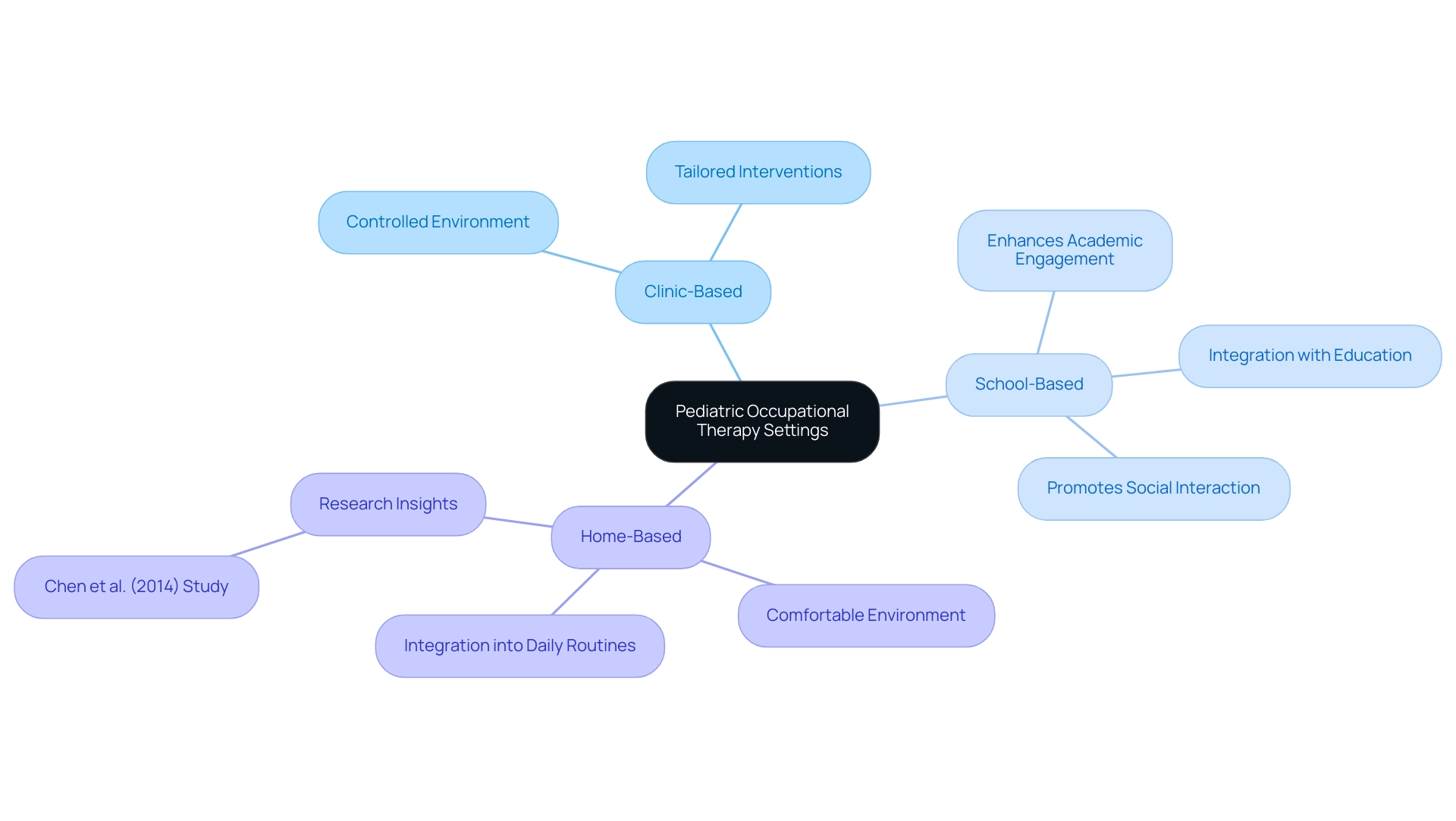
4. The Importance of Early Intervention in Therapy
Research shows that early assistance in occupational pediatric therapy is essential for achieving significant advancements in developmental outcomes. Starting therapy at a young age significantly enhances the chances of individuals overcoming challenges related to motor skills, social interactions, and sensory processing. A recent study, which included a nationally representative sample, highlighted how addressing individual phenotypic traits through early childhood support systems can inform future research and enhance service delivery.
As highlighted by the Department of Education, utilizing existing demographic data in this manner can assist state Part C programs in better recognizing and supporting individuals who require the aid offered through early assistance services. Additionally, 51% of survey participants offered open-ended qualitative text replies, highlighting the effectiveness of early support strategies. This proactive method motivates caregivers to pursue evaluations and support quickly upon observing delays in growth, as it can significantly improve a young one's future abilities.
Significantly, customizing approaches to an individual's unique strengths and needs is crucial for optimizing these results. The influence of early occupational pediatric therapy on these developmental outcomes emphasizes the critical nature of timely intervention in pediatric care.
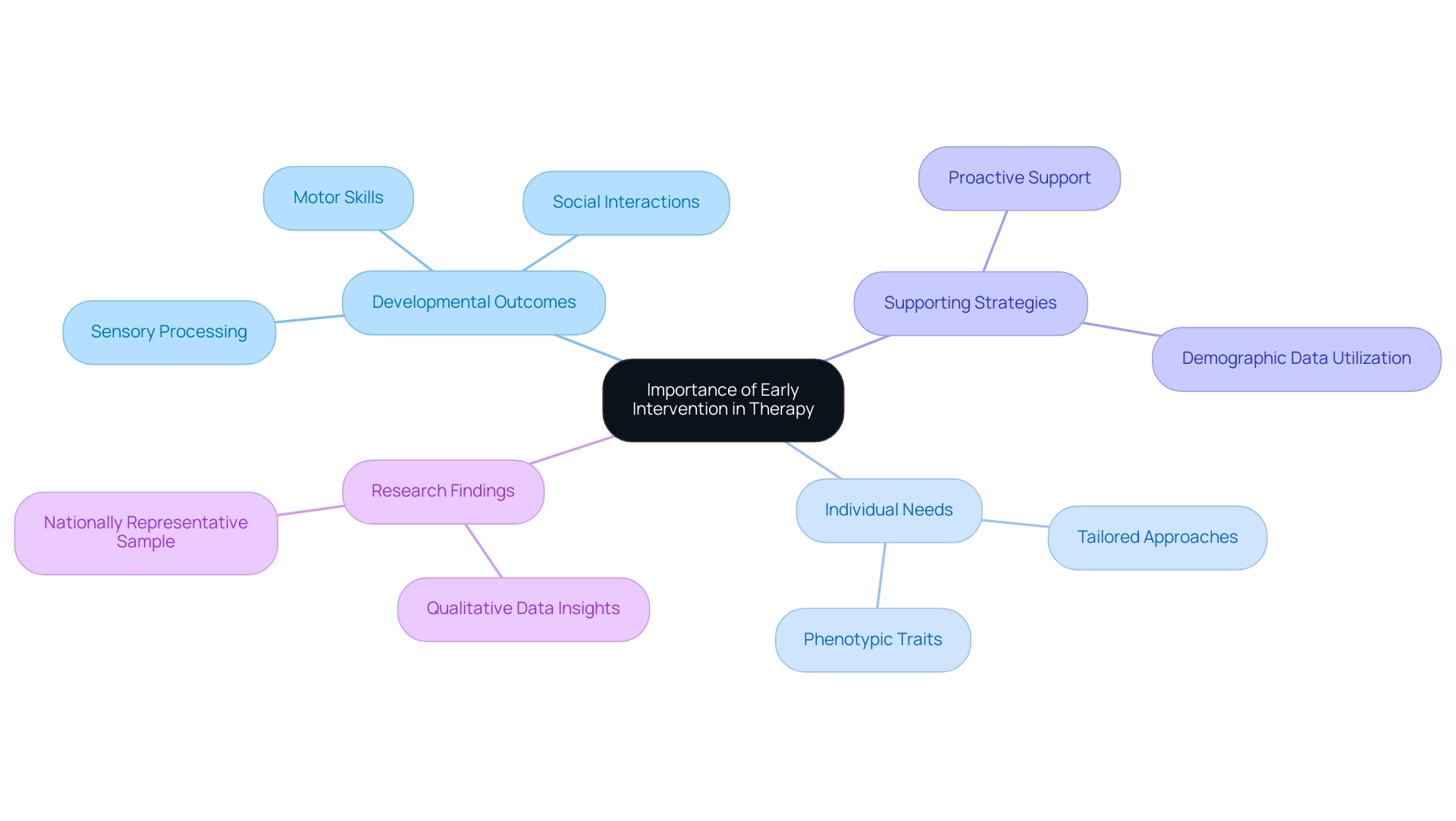
5. Empowering Caregivers: Supporting Your Child's Therapy Journey
The participation of caregivers is essential in the journey of occupational pediatric therapy for their offspring. Effective communication with therapists is vital, allowing caregivers to share observations and concerns regarding their offspring's progress. Participating in daily tasks that enhance skill development strengthens treatment objectives at home.
For instance, a mother of a 4-month-old expressed how she creatively incorporates organizing laundry into fun interactions, which supports her offspring's developmental needs. Research indicates that caregiver involvement significantly enhances treatment outcomes, with an effect size of 0.89 for 'top-down' approaches compared to 0.12 for 'bottom-up' approaches. Additionally, active involvement in treatment sessions provides caregivers with a deeper insight into the strategies being utilized, promoting a holistic approach to the young one's development.
As highlighted in the edited book by Ziviani et al. on goal setting and motivation in treatment, involving both youngsters and parents is crucial for successful results. Additionally, the ongoing usability testing of the Web-based PEM+ prototype aims to provide caregivers with innovative resources and support, enhancing their ability to assist in treatment.
As the evidence base for occupational pediatric therapy continues to expand, particularly regarding interventions for children with cerebral palsy and other disabilities, caregivers are encouraged to utilize the latest resources and case studies to further support their child's occupational pediatric therapy at home.
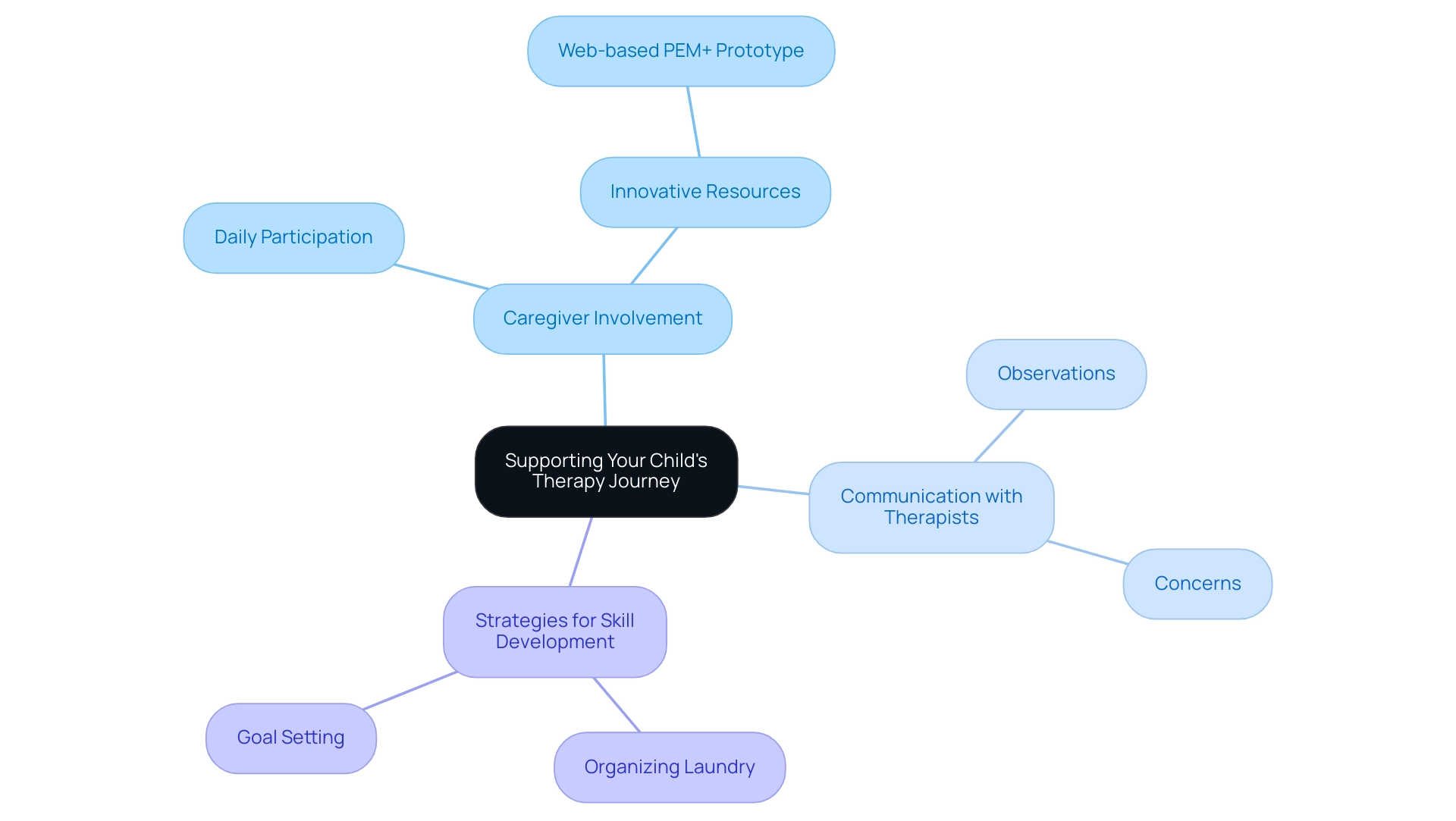
Conclusion
Pediatric Occupational Therapy is instrumental in nurturing children's development by enhancing essential skills required for daily life and academic success. Through individualized assessments and tailored interventions, occupational therapists address a broad spectrum of developmental needs, ranging from fine motor skills to sensory processing and social-emotional growth. The growing emphasis on evidence-based practices and caregiver involvement underscores the importance of a collaborative approach that empowers families to actively participate in their child's developmental journey.
The benefits of pediatric OT are significant, leading to improvements in independence, confidence, and overall quality of life for children. Early intervention is particularly critical, as it dramatically increases the likelihood of overcoming developmental challenges. The diverse settings in which occupational therapy is delivered—whether in clinics, schools, or homes—allow for flexibility and adaptability, ensuring that therapy can seamlessly integrate into a child's daily routine.
Ultimately, the role of caregivers cannot be overstated. Their active participation in therapy not only reinforces therapeutic goals but also fosters a deeper understanding of the strategies employed by therapists. As research continues to evolve, it becomes increasingly clear that a strong partnership between caregivers and occupational therapists is essential for maximizing developmental outcomes. By embracing these practices, families can ensure that every child receives the support they need to thrive.




















